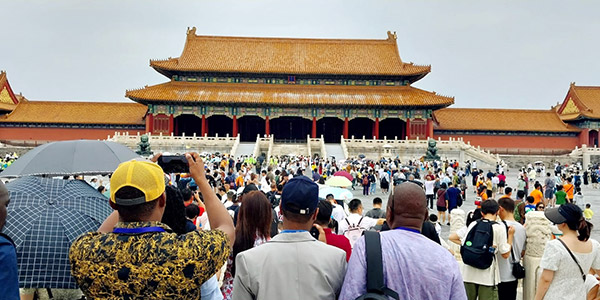 |
| The court inside the complex filled with tourists. |
China’s Forbidden City, a must-visit ancient architectural marvel
Beijing, China: I have worked as a journalist for more than a decade, a period during which I have travelled to several countries in the region and other continents.
I have visited a number of UNESCO World Heritage Sites in Asian countries, with each of them occupying a special place in my memories.
However, my first visit to China’s Forbidden City last week led me to think that this is one of the most stunning and wonderful marvels of the past, and it also made me want to share my experiences with others who may wish to visit this site.
 |
 |
| A group of foreign journalists hear about an iron vat inside the Forbidden City. |
Visitors flock to the entrance of the Forbidden City. |
Millions of tourists have visited the well-preserved ancient palaces built by Chinese emperors during the Ming and Qing dynasties.
According to a brief summary, the Forbidden City is a palace complex located in Dongcheng district of Beijing. It is surrounded by numerous opulent imperial gardens and temples.
The surrounding environment includes Zhongshan Park, spread over an area of 22 hectares, the 69 hectares of the sacrificial Imperial Ancestral Temple and Beihai Park, and the 23 hectares of Jingshan Park.
Historically, the complex was constructed from 1406 to 1420 and it was used as the imperial palace and winter residence of the Emperor of China, from the Ming dynasty to the end of the Qing dynasty between 1420 and 1924.
A visit to the Forbidden City by a group of journalists from Asian, Pacific and African countries was organised last week by the China International Press Communication Centre (CIPCC).
The group was guided by Susan Su, a teacher at the Beijing Language and Culture Centre for Diplomatic Missions.
During the tour, Susan explained the meaning of the words “Forbidden City” and said the complex used to be a palace, and people from outside the palace were not allowed inside because it served as the home of Chinese emperors and their households.
It was used as the ceremonial and political centre of the Chinese government for more than 500 years. The Forbidden City has been under the administration of the Palace Museum since 1925.
She said the complex was declared a World Heritage City in 1987 and also listed by UNESCO as the largest collection of preserved ancient wooden structures in the world.
“The Forbidden City has welcomed tens of millions of visitors annually but the registered figures are unclear, especially during the Covid-19 pandemic. However, it continues to attract more and more visitors to experience the traditional Chinese palatial architecture,” she said.
Susan told the visiting foreign journalists about ancient Chinese architectural styles and patterns, the importance of each palace, and the role of the man-made lakes in the complex.
After an hour-long tour of the Forbidden City, I began to feel that evenn a couple of hours would not be enough for foreign visitors to explore and learn about such an amazing complex built by the skilled Chinese architects.
China is known for its various ethnicities, its art and culture, food and cuisine, as well as its large economy and population.
As one of the temporary foreign residents of Beijing, it will take me more time and at least one or two more visits to the Forbidden City to learn more about this stunning complex and each of the fascinating palaces inside.
Bounfaeng Phaymanivong, a Lao journalist at the Lao Press in Foreign Languages (Vientiane Times), is attending the four-month-long China Asia Pacific Press Centre 2023 Programme, which is initiated by the China Public Diplomacy Association (CPDA) under the framework of the China International Press Communication Centre (CIPCC), along with more than 80 media representatives from almost 70 countries from different continents.
By Bounfaeng Phaymanivong
(Latest Update August 9, 2023)
|